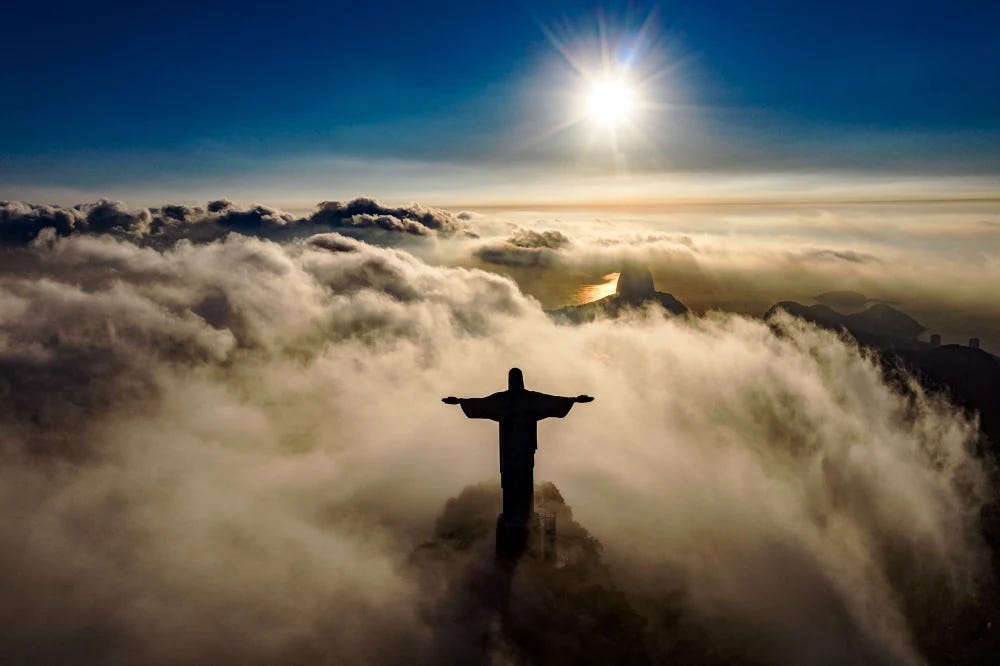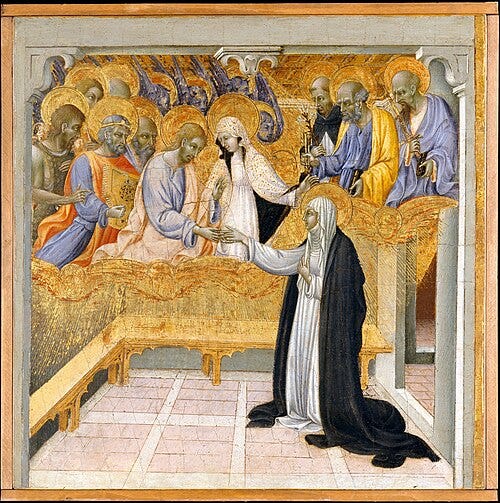Creation is a staggering intellectual edifice filled with hidden features that are only glimpsed when the veil of sequential time is removed. These glimpses are often perceived as “miracles.”
Sequential time, since it is fallen and fragmented eternal time, is a direct result of sin and is the greatest veiling in our present lives. It is keeping God hidden from us, who is fully revealed only in eternal time. In eternal time, the glorified know everything that has happened, is happening, and will happen, just as God does in uncreated everlasting time. In order to experience the eternal, they must become deified (or glorified) to share in God’s nature, to experience eternal time the way God does. Our deaths, glorification, and entry into eternal time are the great unveiling. That is when our knowledge and perception of reality definitively change. Since God exists in eternal everlasting time, it is only in eternal time that we can experience him in his totality. There, Jesus is not hidden behind the veil of words in Scripture, his Creation, the in persona Christi priest, or the accidents of the Eucharist.
He will be present with us and we will freely converse with him, just as Moses and Elijah do on Mt. Tabor at the Transfiguration. This miracle makes no sense if not seen as a miracle of time. The figures are discussing amongst themselves events that have not yet occurred i.e., the Passion and Resurrection. In the miracle, the entire Trinity is present, active, and engaged just as they always are in this true reality where everything is seen as it really is. The Father is heard speaking, the Holy Spirit as a bright cloud “overshadowed them,” and of course, a transfigured Jesus is there casually and rationally conversing with two people who have been dead for centuries.
While he was still speaking, behold, a bright cloud overshadowed them; and suddenly a voice came out of the cloud saying, “This is My beloved Son, in whom I am well pleased. Hear Him!” And when the disciples heard it, they fell on their faces and were greatly afraid. But Jesus came and touched them and said, “Arise and do not be afraid” (Matthew 17: 5-8).
The miracle ends with the veil of sequential time closing and obscuring the reality of eternal time. Jesus’s re-entry into sequential time is denoted by him “touching” the disciples. He is now back and the supernatural bright light they saw shining from him is gone.
When they had lifted up their eyes, they saw no one but Jesus only (Matthew 17:8).
There are several recorded instances of Jesus disappearing from view. For example here is an excerpt from the end of the amazing colloquy Jesus has with the Temple authorities as they sit surrounded by money in their Treasury,
Then the Jews said to Him, “You are not yet fifty years old, and have You seen Abraham?” Jesus said to them, “Most assuredly, I say to you, before Abraham was, I AM.” Then they took up stones to throw at Him; but Jesus hid Himself and went out of the temple, going through the midst of them, and so passed by (John 8:57-59).
The topic they are discussing is time. The Jews do not understand how Jesus could have seen Abraham who lived thousands of years earlier. Jesus answers with the tetragrammaton, telling them “I AM,” in other words, “I am Yahweh,” that’s how! Then Jesus “hid himself,” by stepping back into eternal time, giving them an example of exactly how God’s time works.
In Luke we have a more subtle example of Jesus veiling himself in time,
[The] people in the synagogue were filled with rage... and they got up and drove Him out of the city, and led Him to the brow of the hill on which their city had been built, in order to throw Him down the cliff. But passing through their midst, He went His way” Luke 4:28-30.
The word in Greek translated here as "passing through” is δια or dia. It can mean to pass through a place, but it also can mean to pass through time. With a slight divine adjustment of spacetime, the people can see Jesus, but if he puts himself just a little ahead of their time, he can be gone and out of their grasp before they can react. Sorry, too late!
The Holy Mother is an endless source of fruitful time paradox contemplation, both in who she is as the mother of the Incarnation, and also because of her prophetic powers. The Holy Mother’s apparitions as Our Lady of Good Success in Quito, Ecuador in the 17th century are not nearly as well known as her appearances in Lourdes and Fatima, but are equally astonishing.
At Quito, she accurately prophesied the collapse of the Church and civil society in the mid-20th century that was to come three centuries thence. She warned that because of the laxity of administering the sacrament of Extreme Unction, “many souls will be deprived of innumerable graces, consolations and the strength they need to make that great leap from time to eternity.”1 It is telling that the Holy Mother doesn’t describe the great change after death as going from “this life to the afterlife” or from “earth to heaven” or some such. It is not a change of place; rather, the “great leap” to the afterlife is a change in the way time is experienced, i.e., going from sequential time to eternal time, from our time to the time of God. We will also converse with God and glorified people who are long dead about things that have happened, are happening, and are to come.
The spiritual advisor of the great mystic Catherine of Siena described something similar about her while she was still alive.
Fra Raimondo had come nearer than anyone to understanding this strange woman and the intense life she led, hovering on two wings, as she herself had once expressed it, over the abyss between time and eternity; she touched both shores, but was never allowed to lie down to rest on either of them.2
St. Joseph of Copertino was a 17th century Franciscan friar renowned for his ecstasies, but in particular his levitations. He, like St. Catherine, also existed on the boundary between the natural and supernatural. When asked what people see in divinely-inspired ecstasies, he replied:
They find themselves as if in a great gallery of beautiful things in which hangs a highly polished mirror where they can see, all at once (emphasis mine), every type of yearned for mystery that it pleases God to reveal to them in that great vision.3
Einstein and modern physics would understand exactly what Mary, Catherine, and Joseph are describing and experiencing. In physics, “spacetime” is the mathematical model that fuses the three dimensions of space and the one dimension of time into a single four-dimensional continuum. Spacetime explains relativistic effects, such as why different observers perceive where and when events occur differently. Until Einstein’s theory of special relativity in 1905, it was assumed that the three-dimensional geometry of the universe was completely independent of one-dimensional time. Einstein fused time and space into aspects of one single physical reality known from then on as spacetime.
St. Peter also makes explicit in his first letter that Jesus is outside of time.
And if you call on the Father, who without partiality judges according to each one’s work, conduct yourselves throughout the time you stay here in fear, knowing that you were not redeemed with corruptible things, like silver or gold, from your aimless conduct received by tradition from your fathers, but with the precious blood of Christ, as of a lamb without blemish and without spot. He indeed was foreordained before the foundation of the world, but was manifest in these last times for you (1 Peter: 1:20).
Peter’s phrase “throughout the time you stay here” is perhaps better translated from the Greek as “during the time of your sojourn.” Sojourn is a temporary stay. So, Peter is reminding us of the transience of the time we exist in and admonishes us to be mindful of our conduct because we will be judged without partiality (since God is perfect Truth and can’t do otherwise). However, he also makes explicit that Christ our redeemer, the incarnate God, existed (“was foreordained”) before the world was even created (“before the foundation of the world”). To God, knowledge is not just an abstraction. Since his thoughts are the only Reality, his knowledge of a Redeemer in his eternal time makes the Redeemer real, in this case eternally real, even before he entered into our sequential time and “was manifest in these last times for you.”
So, since sequential time is the fragmentation of time caused by the Fall and the “great leap” to heaven is characterized by a change in the way time is experienced to where the deified can see “all at once,” can Jesus Christ be seen as the Redeemer of Time? In other words, he is the restorer of eternal time?
And he who was seated on the throne said, “Behold, I am making all things new.” Also he said, “Write this down, for these words are trustworthy and true.” And he said to me, “It is done! I am the Alpha and the Omega, the beginning and the end (Revelation 21:5-6).
This Scripture passage does not explicitly tell us that Jesus is the Redeemer of Time, but it can be easily implied. How can Jesus be, let alone “make new,” both the beginning and the end simultaneously? It is simple when we understand that in God’s time “the beginning and the end” are the same eternal moment. In the Greek, this verse is in the present tense. John is not changing tenses and quoting Jesus saying “I was the beginning and I will be the end.” In addition, in the phrase “I am the Alpha and the Omega,” “I am” is I AM or ego ami, in the Greek which alludes to the tetragrammaton. Keeping in mind that the book of Revelation is a book of prophecy, John is shown what is real and known to God because God observes all of time simultaneously.
Steve Skojec, “400 Years Ago, Our Lady Sent Us A Message From Ecuador.” One Peter Five, July 6, 2015, https://onepeterfive.com/400-years-ago-our-lady-sent-us-a-message-from-ecuador/.
Sigrid Undset, Catherine of Siena, trans. Kate Austin-Lund (San Francisco: Ignatius Press, 2009) 234.
Paulo Antonio Agelli, Life of the Blessed Joseph of Copertino, trans. Christopher David Costanzo (North Charleston, SC: CreateSpace Independent Publishing Platform, 2014) 39.









